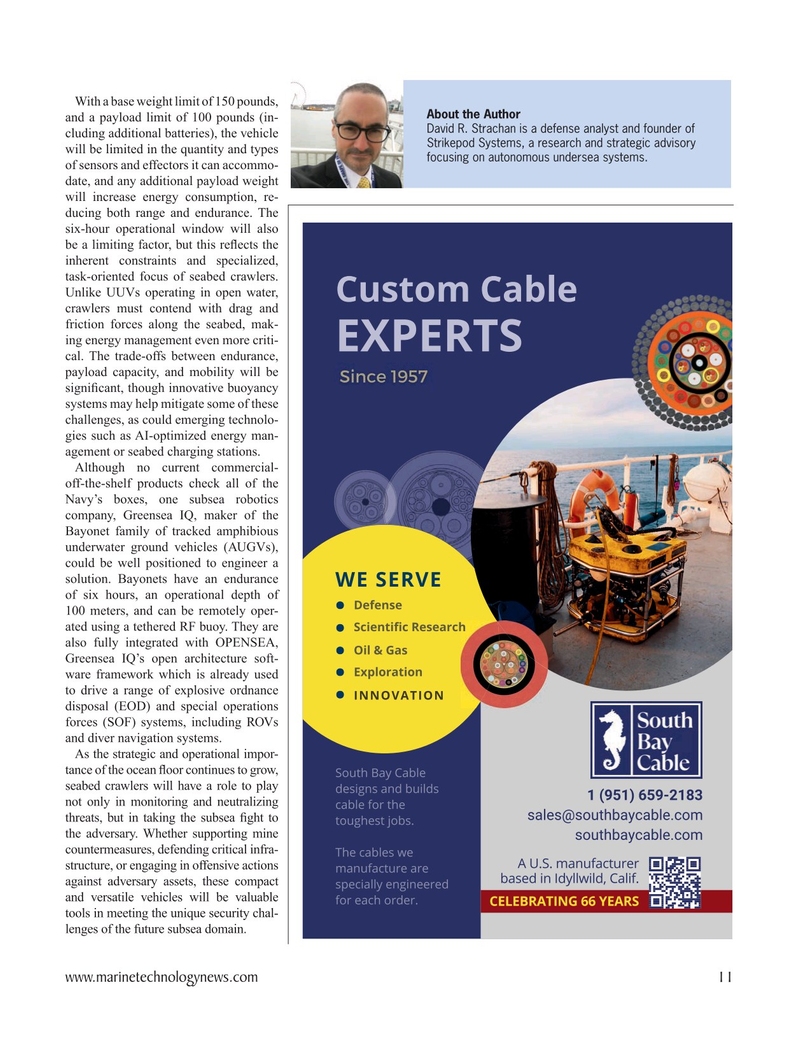
Page 11: of Marine Technology Magazine (January 2025)
Read this page in Pdf, Flash or Html5 edition of January 2025 Marine Technology Magazine
With a base weight limit of 150 pounds,
About the Author and a payload limit of 100 pounds (in-
David R. Strachan is a defense analyst and founder of cluding additional batteries), the vehicle
Strikepod Systems, a research and strategic advisory will be limited in the quantity and types focusing on autonomous undersea systems.
of sensors and effectors it can accommo- date, and any additional payload weight will increase energy consumption, re- ducing both range and endurance. The six-hour operational window will also be a limiting factor, but this re? ects the inherent constraints and specialized, task-oriented focus of seabed crawlers.
Unlike UUVs operating in open water, &XVWRP&DEOH crawlers must contend with drag and friction forces along the seabed, mak- ing energy management even more criti- (;3(576 cal. The trade-offs between endurance, payload capacity, and mobility will be signi? cant, though innovative buoyancy systems may help mitigate some of these challenges, as could emerging technolo- gies such as AI-optimized energy man- agement or seabed charging stations.
Although no current commercial- off-the-shelf products check all of the
Navy’s boxes, one subsea robotics company, Greensea IQ, maker of the
Bayonet family of tracked amphibious underwater ground vehicles (AUGVs), could be well positioned to engineer a solution. Bayonets have an endurance :(6(59( of six hours, an operational depth of 'HIHQVH 100 meters, and can be remotely oper- ated using a tethered RF buoy. They are 6FLHQWLILF5HVHDUFKK also fully integrated with OPENSEA, 2LO *DV
Greensea IQ’s open architecture soft- ([SORUDWLRQ ware framework which is already used to drive a range of explosive ordnance ?1129$7?21 disposal (EOD) and special operations forces (SOF) systems, including ROVs and diver navigation systems.
As the strategic and operational impor- tance of the ocean ? oor continues to grow, 6RXWK%D\&DEOH seabed crawlers will have a role to play
GHVLJQVDQGEXLOGV not only in monitoring and neutralizing
FDEOHIRUWKH
WEPIW$WSYXLFE]GEFPIGSQ threats, but in taking the subsea ? ght to
WRXJKHVWMREV the adversary. Whether supporting mine
WSYXLFE]GEFPIGSQ countermeasures, defending critical infra- 7KHFDEOHVZH $86PDQXIDFWXUHU structure, or engaging in offensive actions
PDQXIDFWXUHDUH
EDVHGLQ?G\OOZLOG&DOLI against adversary assets, these compact
VSHFLDOO\HQJLQHHUHG and versatile vehicles will be valuable
IRUHDFKRUGHU &(/(%5$7?1*<($56 tools in meeting the unique security chal- lenges of the future subsea domain. www.marinetechnologynews.com 11
MTR #1 (1-17).indd 11 2/3/2025 2:18:45 PM

 10
10

 12
12
